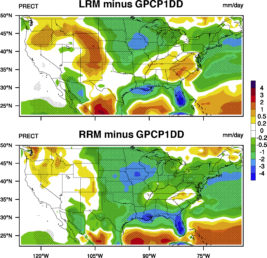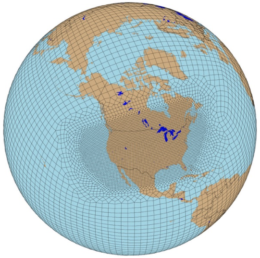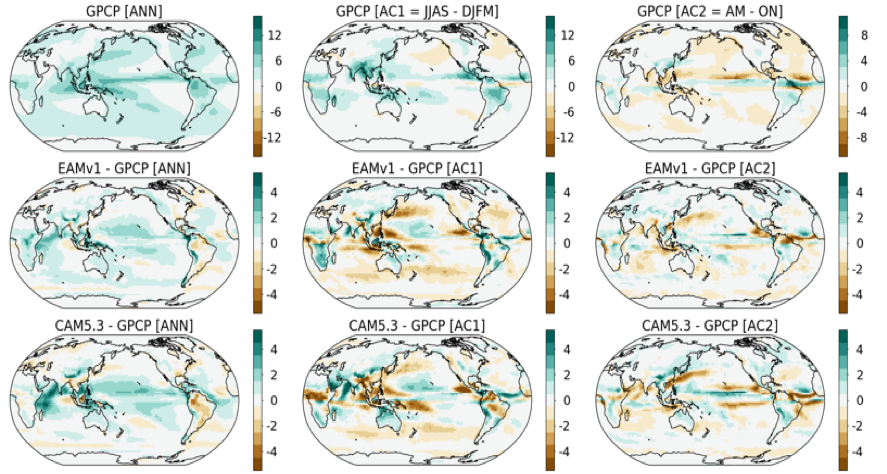v1 Atmosphere
The E3SM Atmosphere Model (EAM) is a descendant of the DOE/NSF supported Community Atmosphere Model version 5.3 (CAM5.3). EAM uses a Spectral Element Dynamical Core at low- (100km, LR) and high- (25 km, HR) resolution. CAM5 vertical resolution was increased from 30 layers, with a top at ~40 km, to 72 layers with a top at 60 km. A variable resolution horizontal grid (termed a regionally refined model, or RRM), is sometimes used to reduce the computational cost of high resolution simulations. Improved or new satellite and ground-based cloud and aerosol simulators were developed to better evaluate clouds, aerosols, and aerosol-cloud interactions.
Innovative Improvements
EAM contains many innovations compared to CAM5. Its physics is broadly similar to CAM6, but many details of tuning, and cloud and aerosols formulations differ in important ways. EAM includes:
CLUBB (Cloud Layers Unified By Binormals) for turbulence and shallow convection
MG2 (Morrison and Gettelman version 2) for stratiform cloud microphysics, with significant additional changes to nucleation and ice microphysics compared to CAM6
The Modal Aerosol Module (MAM4) with revisions to improve aerosol resuspension, convective transport, aerosol nucleation, and scavenging—as well as modifications to sea spray emissions so marine ecosystems can contribute organic matter to aerosols
A linearized ozone photochemistry to predict stratospheric ozone changes, which provides an important source of stratospheric variability including a QBO and increased variability in the high latitude upper troposphere and stratosphere
A better treatment of light-absorbing particle deposition to snowpack and ice is used for the BGC science problem simulations.

Mean June-July-August precipitation biases relative to GPCP estimations are shown for the global uniform LR grid (top panel) and the fine patch of RRM grid (bottom panel, which is almost identical to that seen in simulations with the global uniform HR grid). RRM simulations provide capability for increased resolution in science application regions such as North America.
Higher horizontal and vertical resolution increased the computational cost and changed the simulations substantially given that some important parameterizations are not scale-aware. Parameterization complexity, along with more predicted and transported variables (aerosol species and prognostic snow and rain), also increased cost. Lack of a dedicated machine during the early part of Phase I required development of some innovative strategies to make progress. Short (15-month to 10-year) simulations were used for the LR configuration, but it was not feasible to “brute force” tune the HR configuration. Short-term hindcasts using the Cloud-associated Parameterization Testbed (CAPT) framework were employed to examine some responses to tuning. Longer perturbed parameter ensemble LR simulations provided guidance on appropriate parameters to tune. RRM configurations (Figure above) were also used to explore and evaluate parameterization sensitivity to high resolution with more use planned for science and to improve scale-awareness of parameterizations during Phase II. Well-tuned LR and HR configurations were produced with fidelity comparable to the CAM5 and better than most CMIP5 models. Recent analysis indicates that substantial improvements to these initial tunings are possible and will be pursued as part of the v2 water cycle model development plan.
Figure above displays global precipitation features in EAM v1-LR configuration to CAM5 and observations. Mean errors and monsoon features are substantially improved compared to CAM5. The tuned HR configuration shows smaller SWCF errors than LR (not shown, but particularly in stratocumulus regimes, off SH continents, and polar regions), and better seasonal precipitation and snowpack in the Pacific Northwest (not shown).




